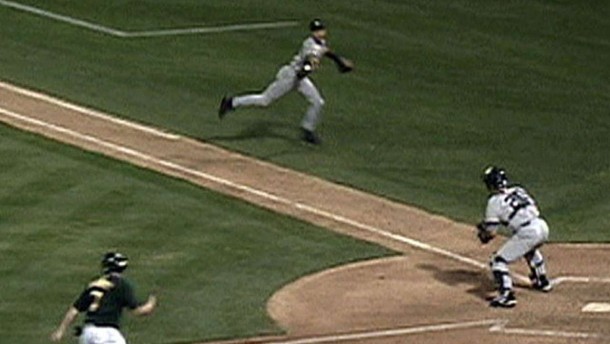The way fans, analysts and the media follow the game of baseball has changed drastically over the past 15-20 years. Prior to that, the game had changed from the 30-40 years before that. Those who follow the game used to be able to judge a good player by the success of their team, the amount of All-Star selections, game-winning RBIs and the amount of MVP votes. Runs batted in and wins recorded by a pitcher used to mean something. Of course, the thought of judging whether a player is good solely off one particular stat may not necessarily tell the entire story. However, stats used to be one of a multitude of resources that were used to judge a player's value. The "eye test" used to be able to determine a lot more in the past than it does now. The game has swung over to the "other side" with statistics (and advanced stats in particular) being the sole way to judge a player's performance.
The sabermetric community has done an outstanding job of using two basic components to determine a ballplayer's worth. Since runs are the determining factor of whether a team wins or loses, getting players on base or preventing players of getting on base has become just as important as scoring runs. The thought is, the more runners on base, the better chance of scoring runs. Conversely, the less runners allowed on base, the less chance of giving up runs. Hence on base percentage (OBP) and walks and hits per inning pitched (WHIP) have become every day stats.
Wins Above Replacement (WAR) is a more complex way to determine the total worth of a player to his team. WAR factors in all elements of a baseball game as it pertains to a particular player - batting, fielding base running and pitching. It basically shows, based off total runs either created or costing a team, how many wins a particular player is worth in comparison to another who will never play in the major leagues (a replacement player).
As positive of a notion as this has all been, there are several things sabermetric statistics do not account for. Games are won or lost because of team chemistry - something that cannot be defined in a stat. There are MLB players who move around from team-to-team that (for whatever reason) always seem to find themselves in the postseason. Some of those players bounce from team-to-team and happen to always play for winning clubs. While this can be considered a coincidence by many of the analytical minds, this writer is convinced that there is some truth to this. Of course, there are good players whose mere presence derails a team's chances of making the postseason.
Another thing that can or may not be quantified is the value of leadership. Leadership does not have to come from a star player, but it can change the complexion of any given clubhouse. Conversely, a clubhouse cancer can destroy chemistry from even the best teams on paper.
No matter how good a certain player may perform over the course of a season, some players come up bigger when the game is on the line. Using the statistic late and close, the numbers will show that certain hitters have a better chance of getting a big hit when the game is on the line. The same can be said when a batter comes up with the bases loaded. It has been stated that a player that gets a favorable amount of "clutch" hits are simply lucky as opposed to this being backed with statistical evidence that proves they are more common to get a hit in this situation. This writer doesn't necessarily agree.
Major League Baseball managers are judged by their win percentage from season to season. Why is it that players are not given credit for wins and the losses (for the most part) the way MLB managers are? There is a stat to show the record a team has in a starting pitcher's starts, but it does not currently exist for position players. What about for relief pitchers? If team records in games started (or appeared in) for position players existed, perhaps some evidence could be shown that a player has a track record for being a "winning" player. And if the track record shows a team is 5-25 in games a particular relief pitcher appeared in, a manager may not want to put said pitcher in a high leverage situation.
Toronto Blue Jays catcher Russell Martin has been in the postseason each of the past five seasons. In 2011-2012 with the New York Yankees and 2013-2014 with the Pittsburgh Pirates before being part of the first Blue Jays team to make the postseason since 1993. One of the more amazing postseason feats was accomplished by outfielder/first baseman Eric Hinske, who managed to be part of four consecutive postseason teams, three of them went to the World Series. Hinske was with the Boston Red Sox in 2007, the Tampa Bay Rays in 2008, the Yankees in 2009, and the Atlanta Braves in 2010. Juan Uribe has been part of six postseasons with four different teams. Catcher David Ross has been in six postseasons with five different teams.
The same example can be made for players that are in the postseason year in and year out, mostly playing for the same team. Derek Jeter and Mariano Rivera played in 16 postseason series for the Yankees. Andy Pettitte pitched in 14 postseasons (13 with the Yankees) and John Smoltz pitched in 14 postseasons (13 with the Braves). Tom Glavine pitched in 13 (12 with the Braves) and Greg Maddux pitched in 13 (10 with the Braves). Roger Clemens pitched in 12 (six with the Yankees, four with the Red Sox and two with the Houston Astros).
The first group can certainly be considered fortunate to be on winning teams. However, there is a good chance Martin's impact on the Yankees, Pirates and Blue Jays had a lot to do with those teams getting to the postseason. In fact, the year Martin left to join the Pirates, the Yankees failed to make the playoffs. And that was precisely why Martin received the five-year contract to be the Blue Jays everyday catcher following the 2014 season.
The second group are all Hall of Fame type players, with the two non HOFers deserving of a nod based off their career records (Yes, Jeter is being counted as a Hall of Famer now). How about a player that has a history of coming up big in the postseason? Pablo Sandoval, Uribe, Edgar Renteria, Kirk Gibson and pitchers like Smoltz, Rivera, Jack Morris and Curt Schilling are among the more recent players to enjoy multiple big time World Series moments. Not all of them are Hall of Famers. There is something to the fact that there are players who rise up to the occasion in the postseason; perhaps more credence can be put to that than that of the "late and close" example that was made before.
Where do we go from here? How about winning percentages for position players and relief pitchers just like it exists for starting pitchers (records in games started)? Postseason appearances (though some are coincidental) can be the start to defining a clubhouse intangible. Unfortunately, there is no computable stat for being a good teammate, or even a leader for that matter. Both are important for defining the ultimate intangible. As the game of baseball has progressed over the past several decades, more information has been used to compile better stats to compute more information. If MLB front offices can better start to define intangibles, it will start a new revolution in the way statistical data is collected.









































